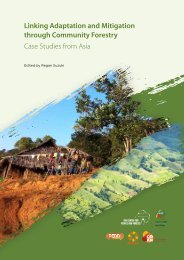Desktop Study on - Regional Climate Change Adaptation ...
Desktop Study on - Regional Climate Change Adaptation ...
Desktop Study on - Regional Climate Change Adaptation ...
Create successful ePaper yourself
Turn your PDF publications into a flip-book with our unique Google optimized e-Paper software.
Assessment of Capacity Gaps and Needs of South East Asia Countries<br />
in Addressing Impacts, Vulnerability and Adaptati<strong>on</strong> to <strong>Climate</strong> Variability and <strong>Climate</strong> <strong>Change</strong><br />
The El Niño-Southern Oscillati<strong>on</strong> (ENSO) c<strong>on</strong>stitutes<br />
<strong>on</strong>e of the main climatic influences <strong>on</strong> Ind<strong>on</strong>esia,<br />
being resp<strong>on</strong>sible for many extreme weather<br />
events, due changes in ocean currents in the Pacific<br />
Ocean and in atmospheric pressure in the southern<br />
hemisphere (UNDP Ind<strong>on</strong>esia, 2007). In the case of El<br />
Niño, the currents are unusually warm, whereas they<br />
are unusually cold in the case of La Niña. At the same<br />
time, El Niño events tend to bring more droughts and<br />
La Niña is often associated with more floods. Other<br />
climate-related hazards include tropical cycl<strong>on</strong>es<br />
in the eastern south Indian Ocean from January to<br />
April as well as in the eastern Pacific Ocean from<br />
May to December. These tropical cycl<strong>on</strong>es and also<br />
the transiti<strong>on</strong>s between Southwest and Northeast<br />
m<strong>on</strong>so<strong>on</strong>s can cause str<strong>on</strong>g winds and heavy rainfall<br />
(UNDP Ind<strong>on</strong>esia, 2007).<br />
Table_8<br />
Overview <strong>on</strong> natural disasters in Ind<strong>on</strong>esia<br />
from 1980 to 2009<br />
Top 5 Natural Disasters in Ind<strong>on</strong>esia for the period 1980-2009<br />
Type of natural<br />
disaster<br />
Earthquake (seismic<br />
activity)<br />
Date/year<br />
May 2006 3,177,923<br />
Wildfire Oct 1994 3,000,000<br />
Drought Sept 1997 1,065,000<br />
Earthquake (seismic<br />
activity)<br />
Sep 2009 450,000<br />
Flood Dec 2006 420,000<br />
Total Natural Disasters* in Ind<strong>on</strong>esia for the period 1980-2009<br />
Type of<br />
natural<br />
disaster<br />
Total no of<br />
events<br />
No of<br />
people<br />
affected<br />
In particular, changes in temperature, rainfall and<br />
seas<strong>on</strong>ality of precipitati<strong>on</strong> have been observed<br />
in different areas of Ind<strong>on</strong>esia. Annual mean<br />
temperature increased during the year between<br />
1901 and 1998 by about 0.3°C (Hulme and Sheard,<br />
1999 cited in Case et al., 2007). Overall annual<br />
precipitati<strong>on</strong> decreased during the same period by<br />
2 to 3% across Ind<strong>on</strong>esia. However, precipitati<strong>on</strong><br />
patterns vary depending <strong>on</strong> the regi<strong>on</strong>. Annual<br />
rainfall has declined in the southern regi<strong>on</strong>s<br />
including Java, Lampung, South Sumatra, South<br />
Sulawesi, and Nusa Tenggara, whereas precipitati<strong>on</strong><br />
has increased in the northern regi<strong>on</strong>s of Ind<strong>on</strong>esia<br />
including most of Kalimantan, North Sulawesi (Boer<br />
and Faqih, 2004 cited in Case et al., 2007). Also, the<br />
seas<strong>on</strong>ality of precipitati<strong>on</strong> has changed differently<br />
in each regi<strong>on</strong>: the wet seas<strong>on</strong> rainfall has increased<br />
in the southern regi<strong>on</strong> while the dry seas<strong>on</strong> rainfall<br />
has decreased in the northern<br />
No of people<br />
affected<br />
Damage<br />
000 US$<br />
Drought 6 1,083,000 89,000<br />
Earthquake<br />
(seismic activity)<br />
73 6,910,847 9,195,726<br />
Epidemic 29 658,923 N/A<br />
Flood 114 7,221,380 2,374,522<br />
Mass movement<br />
(wet)<br />
38 392,945 120,745<br />
regi<strong>on</strong> (ibid). Furthermore, in most<br />
of Sumatra and similarly also in<br />
most of Java, the <strong>on</strong>set of the wet<br />
seas<strong>on</strong> has been observed to be<br />
about 10 - 20 day later in recent<br />
years (1991 - 2003) compared to<br />
three decades ago (1961 - 1990),<br />
whereas the dry seas<strong>on</strong> starts<br />
approximately 10 - 60 days earlier<br />
(Naylor et al., 2007, cited in UNDP<br />
Ind<strong>on</strong>esia, 2007).<br />
Recent years have shown the<br />
tendency that the frequency and<br />
intensity of extreme climatic<br />
events is increasing (Ministry of<br />
Public Works, 2007, cited in UNDP<br />
Ind<strong>on</strong>esia, 2007): while droughts<br />
occurred <strong>on</strong> average every four<br />
years between 1844 and 1960, the<br />
frequency has increased to every<br />
three years in the period 1961 -<br />
2006. Also, the frequency of floods<br />
has increased. However, It seems<br />
to be unclear, whether currently<br />
experienced climatic changes are<br />
a result of increased greenhouse<br />
gas emissi<strong>on</strong>s or whether they<br />
are related with the ENSO, or<br />
a c<strong>on</strong>sequence of both (UNDP<br />
Ind<strong>on</strong>esia, 2007).<br />
Storm 5 14,638 N/A<br />
Volcano 34 612,393 344,190<br />
* not c<strong>on</strong>sidered: mass movement (dry)<br />
Source: EM-DAT (2009): The OFDA /CRED; Internati<strong>on</strong>al Disaster Database; www.emdat.net<br />
- Université Catholique de Louvain – Brussels, – Belgium.<br />
Table 8 shows an overview of<br />
natural disaster related statistics<br />
from Internati<strong>on</strong>al Disaster<br />
Database (EM-DAT, 2009). The<br />
disaster statistics indicate that<br />
71

















